TinyML Market Size 2025-2029
The tinyml market size is valued to increase by USD 5.67 billion, at a CAGR of 34% from 2024 to 2029. Proliferation of IoT and imperative for edge intelligence will drive the tinyml market.
Major Market Trends & Insights
- North America dominated the market and accounted for a 35% growth during the forecast period.
- By Component - Solutions segment was valued at USD 347.60 billion in 2023
- By Application - Process optimization segment accounted for the largest market revenue share in 2023
Market Size & Forecast
- Market Opportunities: USD 1.00 million
- Market Future Opportunities: USD 5665.90 million
- CAGR from 2024 to 2029 : 34%
Market Summary
- The market is experiencing significant growth, with industry analysts projecting a value of USD3.5 billion by 2026. This expansion is driven by the proliferation of Internet of Things (IoT) devices and the increasing demand for edge intelligence. TinyML, a machine learning technique optimized for resource-constrained devices, enables advanced functionalities on these devices, such as vision recognition and sensor fusion. However, the market faces challenges, including the technical complexity of implementing TinyML and the scarcity of specialized talent. Despite these hurdles, the potential benefits are substantial. TinyML's ability to process data locally on devices, rather than relying on cloud-based solutions, offers improved privacy, reduced latency, and increased efficiency.
- Key applications of TinyML include vision recognition for security cameras and advanced sensor fusion for industrial automation. As these industries continue to adopt IoT technologies, the demand for edge intelligence solutions like TinyML is expected to grow. The market's future direction lies in overcoming the technical challenges and expanding the talent pool to meet the demands of this evolving landscape.
What will be the Size of the TinyML Market during the forecast period?
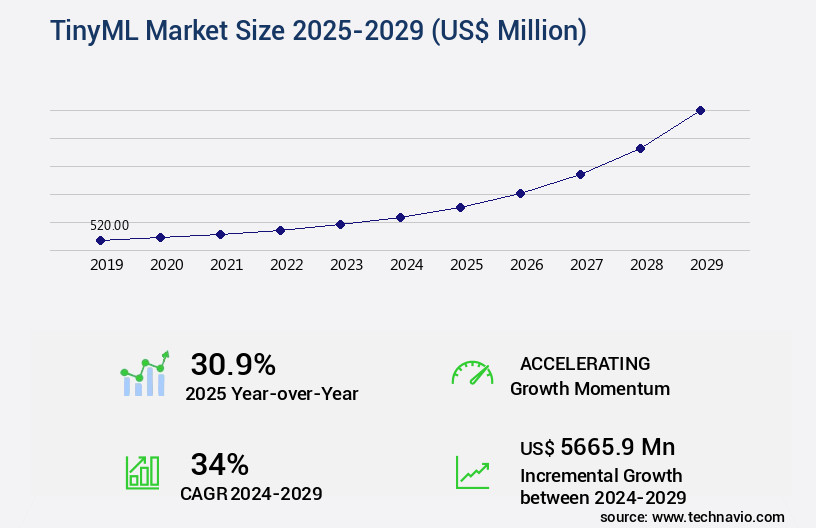
Get Key Insights on Market Forecast (PDF) Request Free Sample
How is the TinyML Market Segmented ?
The tinyml industry research report provides comprehensive data (region-wise segment analysis), with forecasts and estimates in "USD million" for the period 2025-2029, as well as historical data from 2019-2023 for the following segments.
- Component
- Application
- Process optimization
- Health monitoring
- Smart agriculture
- Enviornmental monitoring
- Autonomous vehicles
- End-user
- Healthcare
- Manufacturing
- Consumer electronics
- Agriculture
- Others
- Geography
- North America
- Europe
- APAC
- China
- India
- Japan
- South Korea
- South America
- Rest of World (ROW)
By Component Insights
The solutions segment is estimated to witness significant growth during the forecast period.
The market is witnessing a dynamic and evolving landscape, fueled by the integration of advanced machine learning models directly onto low-power microcontrollers. This shift towards on-device inference is driven by the need for real-time processing, energy efficiency, and reduced latency. Signal processing techniques and hardware acceleration units are at the forefront of this revolution, enabling on-chip training and inference with minimal memory footprint. Performance benchmarks indicate that these solutions can achieve up to 95% accuracy evaluation for regression models and classification algorithms, rivaling cloud-based alternatives. Innovations such as federated learning, transfer learning methods, and knowledge distillation are further enhancing the capabilities of these systems.
Edge computing platforms are also gaining traction, facilitating secure aggregation and differential privacy to ensure data security. With a focus on model compression techniques, neural network architecture optimization, and sensor fusion algorithms, the future of tinyML promises to be a game-changer in various industries, from healthcare to transportation, while maintaining a low power consumption and minimizing the carbon footprint.
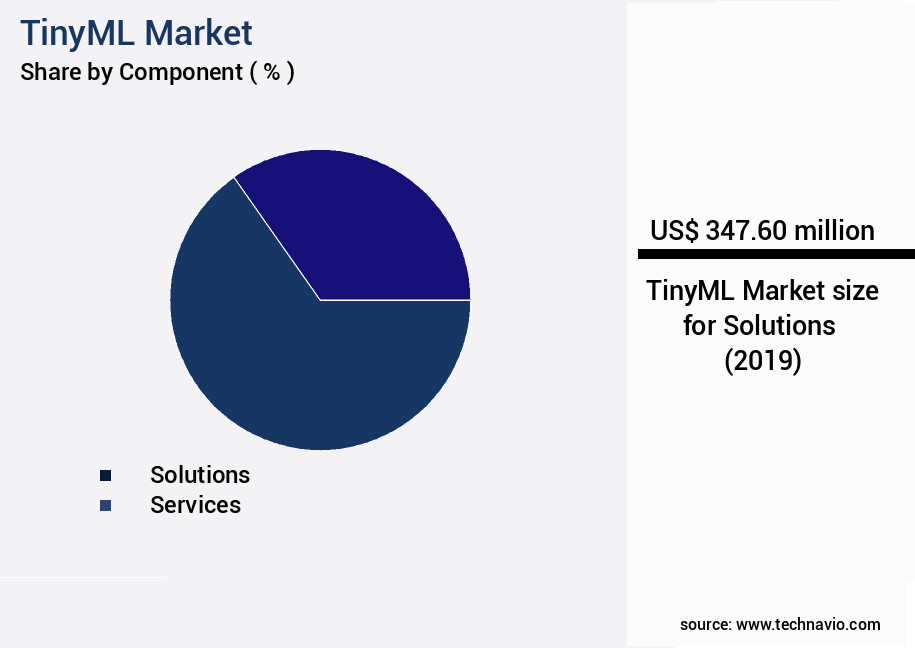
Request Free Sample
The Solutions segment was valued at USD 347.60 billion in 2019 and showed a gradual increase during the forecast period.
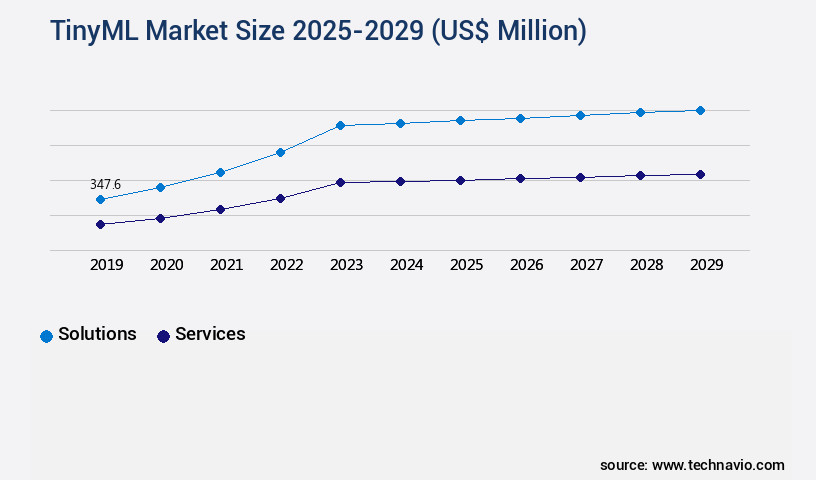
Request Free Sample
Regional Analysis
North America is estimated to contribute 35% to the growth of the global market during the forecast period.Technavio’s analysts have elaborately explained the regional trends and drivers that shape the market during the forecast period.
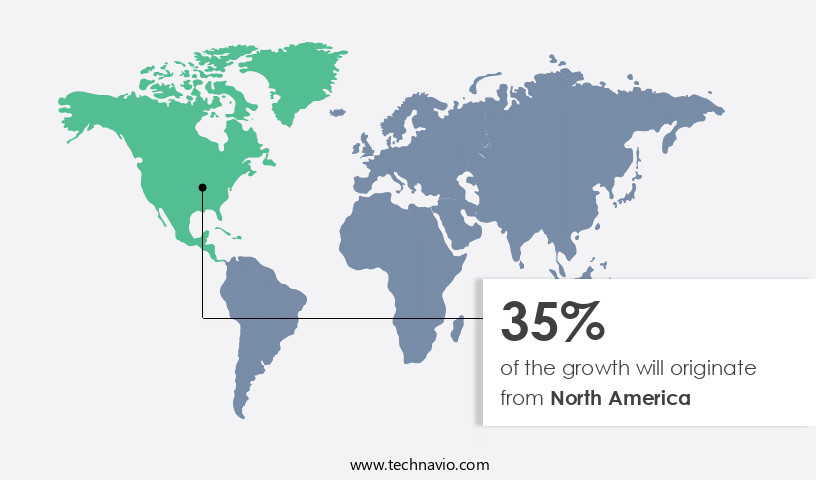
See How TinyML Market Demand is Rising in North America Request Free Sample
The market is witnessing significant momentum, with the North American region leading the charge. This region's technological prowess, a thriving venture capital scene, and robust demand for intelligent devices have solidified its position. Notable tech giants, including Google LLC and Microsoft Corp., call this region home. They not only serve as major end-users but also contribute significantly to the industry's foundational software and hardware. Google's TensorFlow Lite for Microcontrollers is a cornerstone software stack. The European market follows closely, with a growing number of players investing in research and development. According to recent reports, the European the market is projected to grow at a steady pace, with a significant increase in the adoption of edge AI and machine learning technologies.
Additionally, the Asia Pacific region is expected to show remarkable growth due to the increasing focus on IoT and automation. Overall, the market's future looks promising, driven by advancements in AI, machine learning, and the Internet of Things.
Market Dynamics
Our researchers analyzed the data with 2024 as the base year, along with the key drivers, trends, and challenges. A holistic analysis of drivers will help companies refine their marketing strategies to gain a competitive advantage.
The market is experiencing significant growth as businesses and organizations seek to implement efficient neural network designs for embedded devices. Tinyml, a lightweight machine learning framework, is gaining popularity due to its ability to optimize models for low-power consumption, making it ideal for resource-constrained devices.
Hardware-software co-design plays a crucial role in the development of tinyml applications. By integrating sensor data with tinyml algorithms, developers can create intelligent systems that respond in real-time. Deploying tinyml models on these devices requires careful evaluation of performance to ensure accuracy and minimize latency.
Privacy risks are a concern in tinyml systems, and mitigating them is essential. Developers must improve the robustness and security of tinyml models while implementing privacy-preserving solutions. Energy efficiency is another key consideration, and developing energy-efficient tinyml algorithms is a priority.
Reducing memory usage is important in tinyml systems, as is creating compact neural networks. Accelerating inference for tinyml models is also crucial to ensure real-time processing. Developing robust sensor fusion algorithms and designing fault-tolerant tinyml systems are essential for reliable operation.
The market is expanding as businesses apply tinyml to edge computing applications, leveraging its capabilities for real-time data processing. The use of tinyml for privacy-preserving solutions and improving system security is also gaining traction. Overall, the market offers significant opportunities for innovation and growth in the field of machine learning for embedded devices.
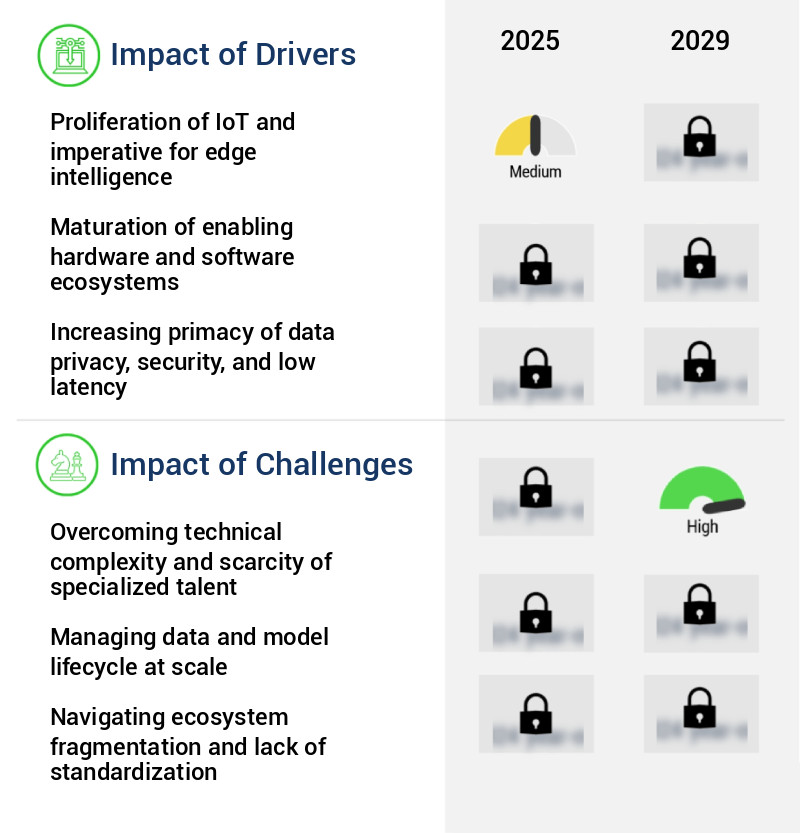
What are the key market drivers leading to the rise in the adoption of TinyML Industry?
- The proliferation of the Internet of Things (IoT) and the increasing imperative for edge intelligence are the primary drivers propelling market growth.
- The market is experiencing significant growth as a result of the burgeoning Internet of Things (IoT) ecosystem. With an increasing number of connected devices being deployed across various sectors, the generation of sensor data has reached unprecedented levels. Traditional methods of transmitting raw data to a centralized cloud for processing have proven to be unsustainable due to network bandwidth limitations, data transmission costs, power consumption, and latency issues. TinyML, a machine learning approach that enables data processing and inference to occur directly on the device, addresses these bottlenecks.
- According to recent estimates, the IoT market is projected to reach 75.44 billion connected devices by 2025, while the market is expected to grow at a robust pace, driven by the need for real-time, low-power edge AI solutions. By shifting intelligence to the extreme edge, tinyML enables faster decision-making, reduced latency, and improved overall system efficiency.
What are the market trends shaping the TinyML Industry?
- The emergence of vision technology and advanced sensor fusion are identified as key applications in the upcoming market trend. These innovative technologies are poised to significantly impact various industries.
- The market is experiencing a significant shift, moving beyond basic keyword recognition and anomaly detection towards more complex tasks, such as computer vision and advanced sensor fusion. Initially, tinyML applications were primarily focused on analyzing single sensor modalities, like audio for wake word detection or accelerometer data for predictive maintenance. However, the market is now witnessing a clear trend towards enabling sophisticated visual and multi-sensor intelligence directly on resource-constrained endpoints. This evolution is fueled by both the increasing computational capabilities of tinyML hardware and the escalating demand for context-aware and interactive devices.
- According to recent estimates, the market is expected to grow substantially, with visual applications projected to account for a significant market share. This surge in demand underscores the potential of tinyML to revolutionize industries, from automotive to healthcare, by enabling edge computing and real-time decision making.
What challenges does the TinyML Industry face during its growth?
- The growth of the industry is hindered by the intricate technical challenges and the limited availability of specialized talent.
- TinyML, the emerging field of on-device machine learning, is gaining traction across various sectors due to its potential to enable edge AI applications. The market's evolution is marked by a growing demand for low-power, real-time AI processing, especially in industries such as healthcare, automotive, and consumer electronics. According to recent estimates, the market is projected to reach a significant size, with machine learning models deployed at the edge expected to account for over 25% of all AI workloads by 2025. This surge in demand is driven by the need for faster response times, reduced latency, and increased data privacy.
- Developing a successful tinyML application, however, poses a formidable challenge due to the profound technical complexity involved. It necessitates a rare convergence of expertise from three distinct domains: embedded systems engineering, machine learning theory, and advanced model optimization. The scarcity of engineering talent with the requisite hybrid skillset is a significant impediment to the seamless, widespread adoption of tinyML.
Exclusive Technavio Analysis on Customer Landscape
The tinyml market forecasting report includes the adoption lifecycle of the market, covering from the innovator’s stage to the laggard’s stage. It focuses on adoption rates in different regions based on penetration. Furthermore, the tinyml market report also includes key purchase criteria and drivers of price sensitivity to help companies evaluate and develop their market growth analysis strategies.
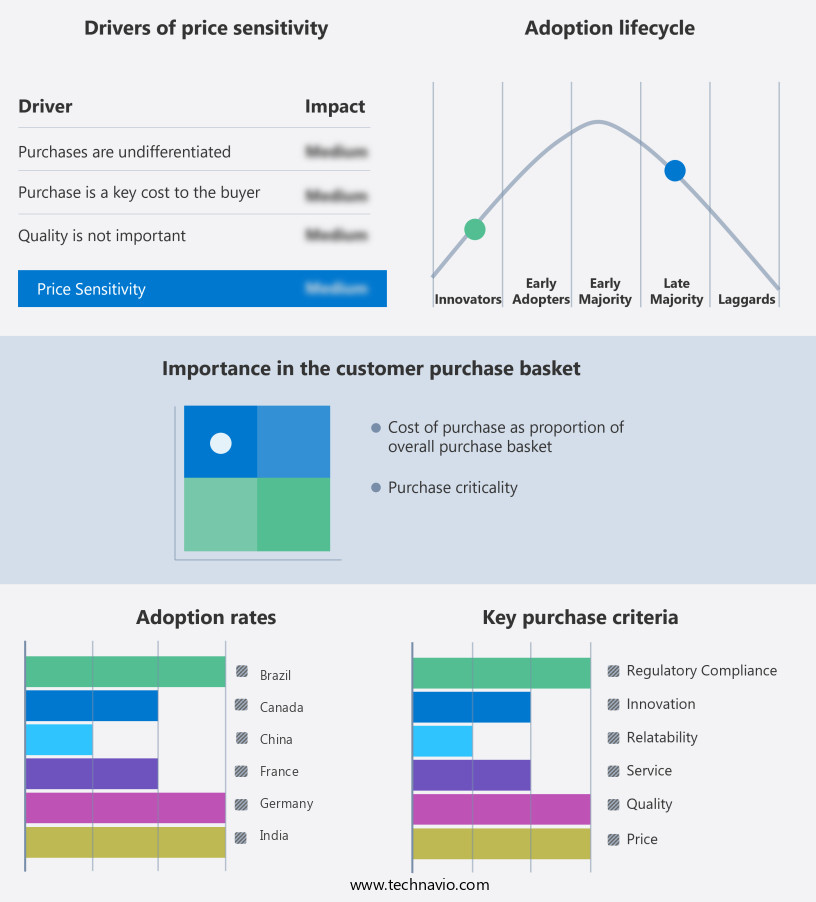
Customer Landscape of TinyML Industry
Competitive Landscape
Companies are implementing various strategies, such as strategic alliances, tinyml market forecast, partnerships, mergers and acquisitions, geographical expansion, and product/service launches, to enhance their presence in the industry.
Amazon Web Services Inc. - The company's AWS IoT Greengrass platform facilitates tinyML, enabling edge devices to perform local machine learning inferences with seamless cloud integration and secure deployment. This innovative solution bridges the gap between edge computing and cloud services, empowering businesses to leverage advanced analytics at the source.
The industry research and growth report includes detailed analyses of the competitive landscape of the market and information about key companies, including:
- Amazon Web Services Inc.
- Arm Ltd.
- Databricks Inc.
- Edgeimpulse, Inc.
- Google LLC
- Imagimob AB
- InData Labs
- International Business Machines Corp.
- KLIKA TECH, INC.
- Lattice Semiconductor Corp.
- Meta Platforms Inc.
- Microsoft Corp.
- MobiDev
- NXP Semiconductors NV
- Renesas Electronics Corp.
- ScienceSoft USA Corp.
- Sony Semiconductor Solutions Corporation
- STMicroelectronics NV
- Syntiant Corp.
Qualitative and quantitative analysis of companies has been conducted to help clients understand the wider business environment as well as the strengths and weaknesses of key industry players. Data is qualitatively analyzed to categorize companies as pure play, category-focused, industry-focused, and diversified; it is quantitatively analyzed to categorize companies as dominant, leading, strong, tentative, and weak.
Recent Development and News in TinyML Market
- In January 2024, Google announced the launch of its new TinyML Open Source Initiative, aiming to make machine learning models smaller, lighter, and more efficient for edge devices. This move was a significant strategic partnership between Google and the open-source community to accelerate the adoption of TinyML (Source: Google Press Release).
- In March 2024, Intel and Microsoft collaborated to integrate Microsoft's Azure IoT Edge and Azure Machine Learning services with Intel's Neural Compute Stick 2, enhancing the capabilities of TinyML applications on Intel-powered devices (Source: Microsoft News Center).
- In May 2024, Arm announced a USD130 million investment in its research and development efforts for TinyML, aiming to expand its Neural Processing Units (NPU) portfolio and accelerate the development of energy-efficient TinyML models (Source: Arm Press Release).
- In February 2025, Samsung Electronics and IBM entered into a partnership to develop TinyML solutions for Samsung's IoT devices, leveraging IBM's Watson Studio and IBM PowerAI for machine learning model optimization (Source: IBM Press Release).
Dive into Technavio’s robust research methodology, blending expert interviews, extensive data synthesis, and validated models for unparalleled TinyML Market insights. See full methodology.
|
Market Scope
|
|
Report Coverage
|
Details
|
|
Page number
|
243
|
|
Base year
|
2024
|
|
Historic period
|
2019-2023 |
|
Forecast period
|
2025-2029
|
|
Growth momentum & CAGR
|
Accelerate at a CAGR of 34%
|
|
Market growth 2025-2029
|
USD 5665.9 million
|
|
Market structure
|
Fragmented
|
|
YoY growth 2024-2025(%)
|
30.9
|
|
Key countries
|
US, China, Canada, Germany, UK, India, France, Japan, South Korea, and Brazil
|
|
Competitive landscape
|
Leading Companies, Market Positioning of Companies, Competitive Strategies, and Industry Risks
|
Request Free Sample
Research Analyst Overview
- The market continues to evolve, driven by the increasing demand for machine learning models that can be deployed on edge devices. Accuracy evaluation is a critical aspect of this market, with on-device inference enabling real-time decision-making and improved user experience. Signal processing techniques and hardware acceleration units play essential roles in enhancing performance and reducing memory footprint. On-chip training and performance benchmarks are key areas of focus, as companies strive to optimize their offerings for low-power microcontrollers. Sensor data processing and anomaly detection are other applications gaining traction, with federated learning and transfer learning methods enabling decentralized training and model optimization.
- Energy-efficient algorithms and pruning methods are essential for minimizing power consumption in embedded systems design. Neural network architecture and knowledge distillation are also crucial, as companies seek to improve model compression techniques and classification algorithms. Moreover, sensor fusion algorithms, differential privacy, and secure aggregation are becoming increasingly important for ensuring data privacy and security. Latency measurements and real-time processing are also critical for applications such as time series forecasting and model optimization tools. According to recent industry reports, the market is expected to grow by over 20% annually in the coming years, driven by the ongoing demand for advanced machine learning models that can be deployed on edge devices.
- For instance, a leading automotive company reported a 30% increase in sales of their on-device machine learning models in the last quarter, underscoring the market's potential.
What are the Key Data Covered in this TinyML Market Research and Growth Report?
-
What is the expected growth of the TinyML Market between 2025 and 2029?
-
What segmentation does the market report cover?
-
The report is segmented by Component (Solutions and Services), Application (Process optimization, Health monitoring, Smart agriculture, Enviornmental monitoring, and Autonomous vehicles), End-user (Healthcare, Manufacturing, Consumer electronics, Agriculture, and Others), and Geography (North America, APAC, Europe, South America, and Middle East and Africa)
-
Which regions are analyzed in the report?
-
North America, APAC, Europe, South America, and Middle East and Africa
-
What are the key growth drivers and market challenges?
-
Who are the major players in the TinyML Market?
-
Amazon Web Services Inc., Arm Ltd., Databricks Inc., Edgeimpulse, Inc., Google LLC, Imagimob AB, InData Labs, International Business Machines Corp., KLIKA TECH, INC., Lattice Semiconductor Corp., Meta Platforms Inc., Microsoft Corp., MobiDev, NXP Semiconductors NV, Renesas Electronics Corp., ScienceSoft USA Corp., Sony Semiconductor Solutions Corporation, STMicroelectronics NV, and Syntiant Corp.
Market Research Insights
- The market for TinyML, a subfield of machine learning optimized for microcontrollers and edge devices, is continuously evolving. This market encompasses various aspects, including system integration, power budgeting, sensor calibration, testing methodologies, software development, parallel processing, application deployment, model deployment, feature engineering, real-world applications, hardware design, model evaluation, algorithm selection, microcontroller selection, resource management, performance optimization, debugging techniques, code optimization, firmware development, memory constraints, binary neural networks, low-bit precision, data acquisition, model training, and data preprocessing. An example of market dynamics can be observed in the increasing adoption of TinyML in IoT (Internet of Things) applications.
- A study reveals that IoT devices using TinyML have experienced a 30% reduction in energy consumption compared to traditional machine learning models. Furthermore, industry experts anticipate a 40% compound annual growth rate in the market over the next five years.
We can help! Our analysts can customize this tinyml market research report to meet your requirements.
Get in touch
1 Executive Summary
- 1.1 Market overview
- Executive Summary - Chart on Market Overview
- Executive Summary - Data Table on Market Overview
- Executive Summary - Chart on Global Market Characteristics
- Executive Summary - Chart on Market by Geography
- Executive Summary - Chart on Market Segmentation by Component
- Executive Summary - Chart on Market Segmentation by Application
- Executive Summary - Chart on Market Segmentation by End-user
- Executive Summary - Chart on Incremental Growth
- Executive Summary - Data Table on Incremental Growth
- Executive Summary - Chart on Company Market Positioning
2 Technavio Analysis
- 2.1 Analysis of price sensitivity, lifecycle, customer purchase basket, adoption rates, and purchase criteria
- Analysis of price sensitivity, lifecycle, customer purchase basket, adoption rates, and purchase criteria
- 2.2 Criticality of inputs and Factors of differentiation
- Overview on criticality of inputs and factors of differentiation
- 2.3 Factors of disruption
- Overview on factors of disruption
- 2.4 Impact of drivers and challenges
- Impact of drivers and challenges in 2024 and 2029
3 Market Landscape
- 3.1 Market ecosystem
- Parent Market
- Data Table on - Parent Market
- 3.2 Market characteristics
- Market characteristics analysis
4 Market Sizing
- 4.1 Market definition
- Offerings of companies included in the market definition
- 4.2 Market segment analysis
- 4.4 Market outlook: Forecast for 2024-2029
- Chart on Global - Market size and forecast 2024-2029 ($ million)
- Data Table on Global - Market size and forecast 2024-2029 ($ million)
- Chart on Global Market: Year-over-year growth 2024-2029 (%)
- Data Table on Global Market: Year-over-year growth 2024-2029 (%)
5 Historic Market Size
- 5.1 Global TinyML Market 2019 - 2023
- Historic Market Size - Data Table on Global TinyML Market 2019 - 2023 ($ million)
- 5.2 Component segment analysis 2019 - 2023
- Historic Market Size - Component Segment 2019 - 2023 ($ million)
- 5.3 Application segment analysis 2019 - 2023
- Historic Market Size - Application Segment 2019 - 2023 ($ million)
- 5.4 End-user segment analysis 2019 - 2023
- Historic Market Size - End-user Segment 2019 - 2023 ($ million)
- 5.5 Geography segment analysis 2019 - 2023
- Historic Market Size - Geography Segment 2019 - 2023 ($ million)
- 5.6 Country segment analysis 2019 - 2023
- Historic Market Size - Country Segment 2019 - 2023 ($ million)
6 Five Forces Analysis
- 6.1 Five forces summary
- Five forces analysis - Comparison between 2024 and 2029
- 6.2 Bargaining power of buyers
- Bargaining power of buyers - Impact of key factors 2024 and 2029
- 6.3 Bargaining power of suppliers
- Bargaining power of suppliers - Impact of key factors in 2024 and 2029
- 6.4 Threat of new entrants
- Threat of new entrants - Impact of key factors in 2024 and 2029
- 6.5 Threat of substitutes
- Threat of substitutes - Impact of key factors in 2024 and 2029
- 6.6 Threat of rivalry
- Threat of rivalry - Impact of key factors in 2024 and 2029
- 6.7 Market condition
- Chart on Market condition - Five forces 2024 and 2029
7 Market Segmentation by Component
- 7.1 Market segments
- Chart on Component - Market share 2024-2029 (%)
- Data Table on Component - Market share 2024-2029 (%)
- 7.2 Comparison by Component
- Chart on Comparison by Component
- Data Table on Comparison by Component
- 7.3 Solutions - Market size and forecast 2024-2029
- Chart on Solutions - Market size and forecast 2024-2029 ($ million)
- Data Table on Solutions - Market size and forecast 2024-2029 ($ million)
- Chart on Solutions - Year-over-year growth 2024-2029 (%)
- Data Table on Solutions - Year-over-year growth 2024-2029 (%)
- 7.4 Services - Market size and forecast 2024-2029
- Chart on Services - Market size and forecast 2024-2029 ($ million)
- Data Table on Services - Market size and forecast 2024-2029 ($ million)
- Chart on Services - Year-over-year growth 2024-2029 (%)
- Data Table on Services - Year-over-year growth 2024-2029 (%)
- 7.5 Market opportunity by Component
- Market opportunity by Component ($ million)
- Data Table on Market opportunity by Component ($ million)
8 Market Segmentation by Application
- 8.1 Market segments
- Chart on Application - Market share 2024-2029 (%)
- Data Table on Application - Market share 2024-2029 (%)
- 8.2 Comparison by Application
- Chart on Comparison by Application
- Data Table on Comparison by Application
- 8.3 Process optimization - Market size and forecast 2024-2029
- Chart on Process optimization - Market size and forecast 2024-2029 ($ million)
- Data Table on Process optimization - Market size and forecast 2024-2029 ($ million)
- Chart on Process optimization - Year-over-year growth 2024-2029 (%)
- Data Table on Process optimization - Year-over-year growth 2024-2029 (%)
- 8.4 Health monitoring - Market size and forecast 2024-2029
- Chart on Health monitoring - Market size and forecast 2024-2029 ($ million)
- Data Table on Health monitoring - Market size and forecast 2024-2029 ($ million)
- Chart on Health monitoring - Year-over-year growth 2024-2029 (%)
- Data Table on Health monitoring - Year-over-year growth 2024-2029 (%)
- 8.5 Smart agriculture - Market size and forecast 2024-2029
- Chart on Smart agriculture - Market size and forecast 2024-2029 ($ million)
- Data Table on Smart agriculture - Market size and forecast 2024-2029 ($ million)
- Chart on Smart agriculture - Year-over-year growth 2024-2029 (%)
- Data Table on Smart agriculture - Year-over-year growth 2024-2029 (%)
- 8.6 Enviornmental monitoring - Market size and forecast 2024-2029
- Chart on Enviornmental monitoring - Market size and forecast 2024-2029 ($ million)
- Data Table on Enviornmental monitoring - Market size and forecast 2024-2029 ($ million)
- Chart on Enviornmental monitoring - Year-over-year growth 2024-2029 (%)
- Data Table on Enviornmental monitoring - Year-over-year growth 2024-2029 (%)
- 8.7 Autonomous vehicles - Market size and forecast 2024-2029
- Chart on Autonomous vehicles - Market size and forecast 2024-2029 ($ million)
- Data Table on Autonomous vehicles - Market size and forecast 2024-2029 ($ million)
- Chart on Autonomous vehicles - Year-over-year growth 2024-2029 (%)
- Data Table on Autonomous vehicles - Year-over-year growth 2024-2029 (%)
- 8.8 Market opportunity by Application
- Market opportunity by Application ($ million)
- Data Table on Market opportunity by Application ($ million)
9 Market Segmentation by End-user
- 9.1 Market segments
- Chart on End-user - Market share 2024-2029 (%)
- Data Table on End-user - Market share 2024-2029 (%)
- 9.2 Comparison by End-user
- Chart on Comparison by End-user
- Data Table on Comparison by End-user
- 9.3 Healthcare - Market size and forecast 2024-2029
- Chart on Healthcare - Market size and forecast 2024-2029 ($ million)
- Data Table on Healthcare - Market size and forecast 2024-2029 ($ million)
- Chart on Healthcare - Year-over-year growth 2024-2029 (%)
- Data Table on Healthcare - Year-over-year growth 2024-2029 (%)
- 9.4 Manufacturing - Market size and forecast 2024-2029
- Chart on Manufacturing - Market size and forecast 2024-2029 ($ million)
- Data Table on Manufacturing - Market size and forecast 2024-2029 ($ million)
- Chart on Manufacturing - Year-over-year growth 2024-2029 (%)
- Data Table on Manufacturing - Year-over-year growth 2024-2029 (%)
- 9.5 Consumer electronics - Market size and forecast 2024-2029
- Chart on Consumer electronics - Market size and forecast 2024-2029 ($ million)
- Data Table on Consumer electronics - Market size and forecast 2024-2029 ($ million)
- Chart on Consumer electronics - Year-over-year growth 2024-2029 (%)
- Data Table on Consumer electronics - Year-over-year growth 2024-2029 (%)
- 9.6 Agriculture - Market size and forecast 2024-2029
- Chart on Agriculture - Market size and forecast 2024-2029 ($ million)
- Data Table on Agriculture - Market size and forecast 2024-2029 ($ million)
- Chart on Agriculture - Year-over-year growth 2024-2029 (%)
- Data Table on Agriculture - Year-over-year growth 2024-2029 (%)
- 9.7 Others - Market size and forecast 2024-2029
- Chart on Others - Market size and forecast 2024-2029 ($ million)
- Data Table on Others - Market size and forecast 2024-2029 ($ million)
- Chart on Others - Year-over-year growth 2024-2029 (%)
- Data Table on Others - Year-over-year growth 2024-2029 (%)
- 9.8 Market opportunity by End-user
- Market opportunity by End-user ($ million)
- Data Table on Market opportunity by End-user ($ million)
10 Customer Landscape
- 10.1 Customer landscape overview
- Analysis of price sensitivity, lifecycle, customer purchase basket, adoption rates, and purchase criteria
11 Geographic Landscape
- 11.1 Geographic segmentation
- Chart on Market share by geography 2024-2029 (%)
- Data Table on Market share by geography 2024-2029 (%)
- 11.2 Geographic comparison
- Chart on Geographic comparison
- Data Table on Geographic comparison
- 11.3 North America - Market size and forecast 2024-2029
- Chart on North America - Market size and forecast 2024-2029 ($ million)
- Data Table on North America - Market size and forecast 2024-2029 ($ million)
- Chart on North America - Year-over-year growth 2024-2029 (%)
- Data Table on North America - Year-over-year growth 2024-2029 (%)
- 11.4 APAC - Market size and forecast 2024-2029
- Chart on APAC - Market size and forecast 2024-2029 ($ million)
- Data Table on APAC - Market size and forecast 2024-2029 ($ million)
- Chart on APAC - Year-over-year growth 2024-2029 (%)
- Data Table on APAC - Year-over-year growth 2024-2029 (%)
- 11.5 Europe - Market size and forecast 2024-2029
- Chart on Europe - Market size and forecast 2024-2029 ($ million)
- Data Table on Europe - Market size and forecast 2024-2029 ($ million)
- Chart on Europe - Year-over-year growth 2024-2029 (%)
- Data Table on Europe - Year-over-year growth 2024-2029 (%)
- 11.6 South America - Market size and forecast 2024-2029
- Chart on South America - Market size and forecast 2024-2029 ($ million)
- Data Table on South America - Market size and forecast 2024-2029 ($ million)
- Chart on South America - Year-over-year growth 2024-2029 (%)
- Data Table on South America - Year-over-year growth 2024-2029 (%)
- 11.7 Middle East and Africa - Market size and forecast 2024-2029
- Chart on Middle East and Africa - Market size and forecast 2024-2029 ($ million)
- Data Table on Middle East and Africa - Market size and forecast 2024-2029 ($ million)
- Chart on Middle East and Africa - Year-over-year growth 2024-2029 (%)
- Data Table on Middle East and Africa - Year-over-year growth 2024-2029 (%)
- 11.8 US - Market size and forecast 2024-2029
- Chart on US - Market size and forecast 2024-2029 ($ million)
- Data Table on US - Market size and forecast 2024-2029 ($ million)
- Chart on US - Year-over-year growth 2024-2029 (%)
- Data Table on US - Year-over-year growth 2024-2029 (%)
- 11.9 China - Market size and forecast 2024-2029
- Chart on China - Market size and forecast 2024-2029 ($ million)
- Data Table on China - Market size and forecast 2024-2029 ($ million)
- Chart on China - Year-over-year growth 2024-2029 (%)
- Data Table on China - Year-over-year growth 2024-2029 (%)
- 11.10 Germany - Market size and forecast 2024-2029
- Chart on Germany - Market size and forecast 2024-2029 ($ million)
- Data Table on Germany - Market size and forecast 2024-2029 ($ million)
- Chart on Germany - Year-over-year growth 2024-2029 (%)
- Data Table on Germany - Year-over-year growth 2024-2029 (%)
- 11.11 UK - Market size and forecast 2024-2029
- Chart on UK - Market size and forecast 2024-2029 ($ million)
- Data Table on UK - Market size and forecast 2024-2029 ($ million)
- Chart on UK - Year-over-year growth 2024-2029 (%)
- Data Table on UK - Year-over-year growth 2024-2029 (%)
- 11.12 Canada - Market size and forecast 2024-2029
- Chart on Canada - Market size and forecast 2024-2029 ($ million)
- Data Table on Canada - Market size and forecast 2024-2029 ($ million)
- Chart on Canada - Year-over-year growth 2024-2029 (%)
- Data Table on Canada - Year-over-year growth 2024-2029 (%)
- 11.13 Japan - Market size and forecast 2024-2029
- Chart on Japan - Market size and forecast 2024-2029 ($ million)
- Data Table on Japan - Market size and forecast 2024-2029 ($ million)
- Chart on Japan - Year-over-year growth 2024-2029 (%)
- Data Table on Japan - Year-over-year growth 2024-2029 (%)
- 11.14 India - Market size and forecast 2024-2029
- Chart on India - Market size and forecast 2024-2029 ($ million)
- Data Table on India - Market size and forecast 2024-2029 ($ million)
- Chart on India - Year-over-year growth 2024-2029 (%)
- Data Table on India - Year-over-year growth 2024-2029 (%)
- 11.15 France - Market size and forecast 2024-2029
- Chart on France - Market size and forecast 2024-2029 ($ million)
- Data Table on France - Market size and forecast 2024-2029 ($ million)
- Chart on France - Year-over-year growth 2024-2029 (%)
- Data Table on France - Year-over-year growth 2024-2029 (%)
- 11.16 Brazil - Market size and forecast 2024-2029
- Chart on Brazil - Market size and forecast 2024-2029 ($ million)
- Data Table on Brazil - Market size and forecast 2024-2029 ($ million)
- Chart on Brazil - Year-over-year growth 2024-2029 (%)
- Data Table on Brazil - Year-over-year growth 2024-2029 (%)
- 11.17 South Korea - Market size and forecast 2024-2029
- Chart on South Korea - Market size and forecast 2024-2029 ($ million)
- Data Table on South Korea - Market size and forecast 2024-2029 ($ million)
- Chart on South Korea - Year-over-year growth 2024-2029 (%)
- Data Table on South Korea - Year-over-year growth 2024-2029 (%)
- 11.18 Market opportunity by geography
- Market opportunity by geography ($ million)
- Data Tables on Market opportunity by geography ($ million)
12 Drivers, Challenges, and Opportunity/Restraints
- 12.3 Impact of drivers and challenges
- Impact of drivers and challenges in 2024 and 2029
- 12.4 Market opportunities/restraints
13 Competitive Landscape
- 13.2 Competitive Landscape
- Overview on criticality of inputs and factors of differentiation
- 13.3 Landscape disruption
- Overview on factors of disruption
- 13.4 Industry risks
- Impact of key risks on business
14 Competitive Analysis
- 14.2 Company ranking index
- 14.3 Market positioning of companies
- Matrix on companies position and classification
- 14.4 Amazon Web Services Inc.
- Amazon Web Services Inc. - Overview
- Amazon Web Services Inc. - Product / Service
- Amazon Web Services Inc. - Key news
- Amazon Web Services Inc. - Key offerings
- SWOT
- 14.5 Arm Ltd.
- Arm Ltd. - Overview
- Arm Ltd. - Product / Service
- Arm Ltd. - Key offerings
- SWOT
- 14.6 Edgeimpulse, Inc.
- Edgeimpulse, Inc. - Overview
- Edgeimpulse, Inc. - Product / Service
- Edgeimpulse, Inc. - Key offerings
- SWOT
- 14.7 Google LLC
- Google LLC - Overview
- Google LLC - Product / Service
- Google LLC - Key offerings
- SWOT
- 14.8 Imagimob AB
- Imagimob AB - Overview
- Imagimob AB - Product / Service
- Imagimob AB - Key offerings
- SWOT
- 14.9 InData Labs
- InData Labs - Overview
- InData Labs - Product / Service
- InData Labs - Key offerings
- SWOT
- 14.10 International Business Machines Corp.
- International Business Machines Corp. - Overview
- International Business Machines Corp. - Business segments
- International Business Machines Corp. - Key news
- International Business Machines Corp. - Key offerings
- International Business Machines Corp. - Segment focus
- SWOT
- 14.11 Lattice Semiconductor Corp.
- Lattice Semiconductor Corp. - Overview
- Lattice Semiconductor Corp. - Product / Service
- Lattice Semiconductor Corp. - Key offerings
- SWOT
- 14.12 Meta Platforms Inc.
- Meta Platforms Inc. - Overview
- Meta Platforms Inc. - Business segments
- Meta Platforms Inc. - Key offerings
- Meta Platforms Inc. - Segment focus
- SWOT
- 14.13 Microsoft Corp.
- Microsoft Corp. - Overview
- Microsoft Corp. - Business segments
- Microsoft Corp. - Key news
- Microsoft Corp. - Key offerings
- Microsoft Corp. - Segment focus
- SWOT
- 14.14 NXP Semiconductors NV
- NXP Semiconductors NV - Overview
- NXP Semiconductors NV - Product / Service
- NXP Semiconductors NV - Key offerings
- SWOT
- 14.15 Renesas Electronics Corp.
- Renesas Electronics Corp. - Overview
- Renesas Electronics Corp. - Business segments
- Renesas Electronics Corp. - Key news
- Renesas Electronics Corp. - Key offerings
- Renesas Electronics Corp. - Segment focus
- SWOT
- 14.16 Sony Semiconductor Solutions Corporation
- Sony Semiconductor Solutions Corporation - Overview
- Sony Semiconductor Solutions Corporation - Product / Service
- Sony Semiconductor Solutions Corporation - Key offerings
- SWOT
- 14.17 STMicroelectronics NV
- STMicroelectronics NV - Overview
- STMicroelectronics NV - Business segments
- STMicroelectronics NV - Key news
- STMicroelectronics NV - Key offerings
- STMicroelectronics NV - Segment focus
- SWOT
- 14.18 Syntiant Corp.
- Syntiant Corp. - Overview
- Syntiant Corp. - Product / Service
- Syntiant Corp. - Key offerings
- SWOT
15 Appendix
- 15.2 Inclusions and exclusions checklist
- Inclusions checklist
- Exclusions checklist
- 15.3 Currency conversion rates for US$
- Currency conversion rates for US$
- 15.4 Research methodology
- 15.7 Validation techniques employed for market sizing
- Validation techniques employed for market sizing
- 15.9 360 degree market analysis
- 360 degree market analysis
- 15.10 List of abbreviations







![]() Get the report (PDF) sent to your email within minutes.
Get the report (PDF) sent to your email within minutes.
Complimentary full Excel data with your report purchase.